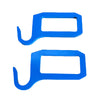News
 This past June, Jim Spinella of New Jersey set a new long-distance rifle shooting world record, for hitting a 36” steel target from the unbelievable distance of 3,800 yards. That’s over two miles!
This past June, Jim Spinella of New Jersey set a new long-distance rifle shooting world record, for hitting a 36” steel target from the unbelievable distance of 3,800 yards. That’s over two miles!
Most of us don’t even hope to achieve a hit close to that distance, but we can all participate in the thrill of long-range shooting. This exciting, challenging sport is a great way to develop your target shooting skills or to become a more successful hunter.
What does it take to hit a target beyond a couple hundred yards? Practice, of course, plus the right tools, and a few insider tips.
Long-range Shooting Tools
Long-range rifles
First, you’ll need an accurate rifle. Most long-range rifles are a bit heavier than standard rifles, with finely tuned triggers and a milled aluminum bedding system for the action. Barrels are twist-tuned, which means the rifling twist along the barrel is matched to specific bullet weights.
Popular makers of long-range rifles include Remington, which makes more than a dozen, along with Ruger and Savage. Custom rifles, which can cost thousands of dollars, typically utilize higher-end barrels, actions and triggers.
Ammunition
Whether you’re long-range target shooting or hunting, you’ll want to use hard-hitting, fast cartridges that fly efficiently through the air. Heavier, longer bullets have a higher Ballistic Coefficient (BC), which is better for long ranges than a lower one. A BC above .70 is best, between .60 and .70 is great, and between .50 and .60 is good. You also want a fast muzzle velocity.
As far as caliber goes, the .308 Winchester is a great way to start. It shoots a .51 BC bullet at 2650 – 2850 feet per second. Other good long-range calibers are the .30-06, .300 Winchester Magnum, 7mm Remington Magnum, 280 Remington, and the .243 Winchester. You can purchase factory match ammunition, or reload your own.
Riflescopes
You’ll need a scope designed for long-range shooting with reticles and turrets to account for wind and elevation. Many long-range scopes come with a mil-dot reticle, which is effective but requires a skilled spotter, and can be confusing to learn. A common duplex reticle and custom elevation dials, such as those found on Leupold’s CDS scope, is a good alternative. The dials match the trajectory profile of your ammunition.
Scope mounts are key to your riflescope’s accuracy, so don’t skimp on them.
Accessories
Long-range shooting is done from the prone position, so you’ll need a bipod to rest the barrel on and you may want a beanbag for the stock. Try a cheek rest, for proper eye positioning behind the scope. You’ll also need a rangefinder to tell you the precise distance of the target. View our long-range target packages.
Long-range Shooting Tips
- In a 5-mph wind, a .308 bullet can drift 12 inches at 500 yards. That’s why wind speed and direction is so important in long-range shooting. If there is no wind to speak of, just aim for the center of the steel target. If you don’t know the exact speed, you can correct by holding to the left (for left-to right direction) or right (for right-to-left) a half- or full-target, and adjusting accordingly.
- It’s more important to know what the wind is doing down range, so watch it about midway to your steel target.
- Heavier, faster and more streamlined bullets are less affected by the wind.
- Invest in a few lessons to learn how to set up your riflescope, how to adjust for wind and of course, proper breathing and trigger techniques.
- Learning to be consistent is important to building any skill, and it’s true for long-range shooting, too. Be sure you’re consistent with rifle set up, ammunition, trigger pull and practice time.
- You can spend a lot or a little on your rifle and accessories. Do your research to find out what package works best for your budget and objectives.



